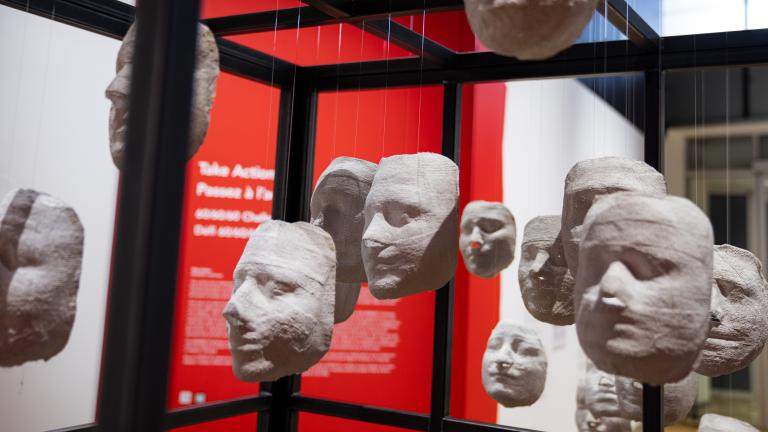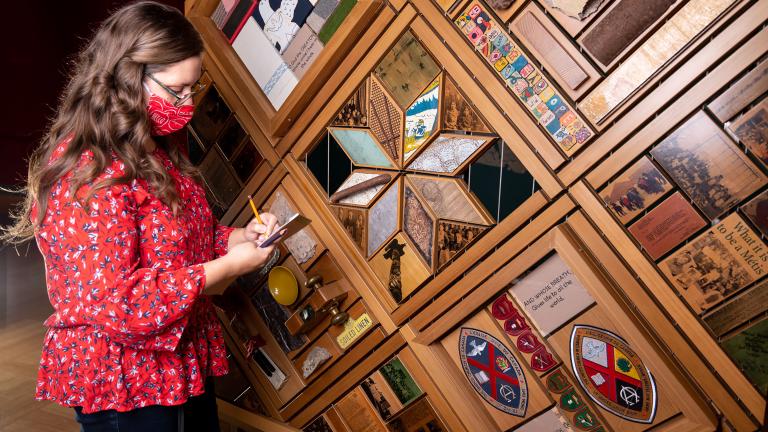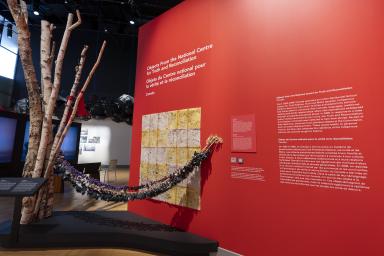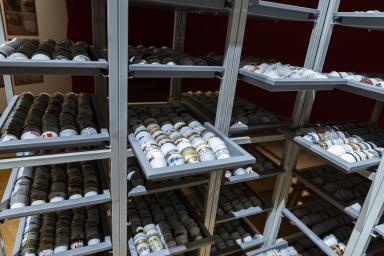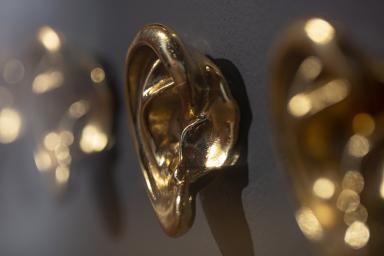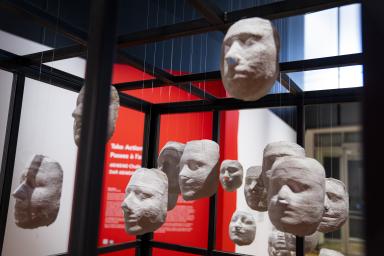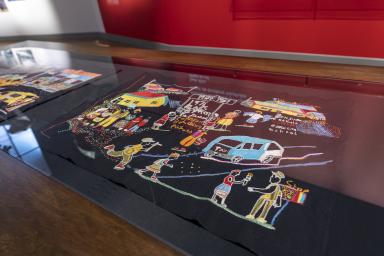This release is more than two years old
This release is more than two years old. For additional information, please contact Amanda Gaudes from our Media Relations team.
News release details
Powerful works of art that have inspired action for human rights around the world are featured in two exhibitions opening tomorrow (April 30) at the Canadian Museum for Human Rights (CMHR). See video.
Faces of captured Yazidi women, preserved in paper‐mâché, dangle from the bars of a steel cage. On a forensic examiner’s rack, 8,372 Bosnian fildžani (tiny coffee cups) are arranged in trays. Golden “trophy” ears from Indonesia are set beneath a soundscape of whispers and forbidden songs. Hundreds of objects from Indian residential schools in Canada rest in a cedar frame, forming a “blanket” of truth and memory.
“These artists have taken action, through their work, for a world that respects the rights and dignity of all people,” said CMHR CEO Isha Khan. “Their ‘artivism’ helps us understand that we all have a role in recognizing and preventing mass violence and genocide. Sometimes, art is the only way these important messages can reverberate and prevail, especially at times when dissenting voices are silenced.”
The North American premiere of Artivism presents works by artists and art collectives from Argentina, Bosnia and Herzegovina, Indonesia, Iraqi Kurdistan and South Africa, along with art and sacred objects from Canada’s National Centre for Truth and Reconciliation at the University of Manitoba. The exhibition – shown only once before at the prestigious Venice Biennale in 2019 – encourages visitors to confront the reality of past atrocities and commit to undertaking actions that create change in their own communities.
Witness Blanket: Preserving a Legacy is the first public display of this monumental Canadian artwork since the Museum and artist Carey Newman forged a unique and historic agreement in 2019 to become its mutual caretakers. Visitors will be introduced to the special conservation needs of this challenging installation, made of more than 800 objects that hold the Stories of residential school survivors from across the country.
Artivism was developed by the Auschwitz Institute for the Prevention of Genocide and Mass Atrocities, curated by Kerry Whigham, Francesca Giubilei and Luca Berta. It includes a “60/60/60 Challenge,” created in collaboration with the National Center for Civil and Human Rights in Atlanta, Georgia. The challenge urges visitors to take specific actions for human rights (outlined on an array of cards) – whether they have 60 seconds, 60 hours or 60 days to devote. The exhibition is generously supported by the Burns Family Foundation and Canada Life.
The Witness Blanket is a work of national importance created by Kwakwaka’wakw and Coast Salish artist Carey Newman (Hayalthkin’geme), a master carver based in Victoria. The 12‐metre‐long artwork, embedded with objects retrieved from the sites and survivors of every Indian Residential School in Canada, has become a framework for conversations about the genocide of Indigenous peoples in Canada. Its current exhibition has been generously supported with major funding by lead partner TD Ready Commitment, with additional support from The Winnipeg Foundation.
The backgrounder below includes more information about the two exhibitions, which run together in the Museum’s spacious Level 1 Gallery until January 16, 2022. Entry is included with general admission. COVID‐19 protocols are strictly observed at the Museum through timed ticketing, social distancing, and rigorous cleaning and sanitation.
High resolution photos are available upon request. A video created for the opening of these exhibitions can be viewed online.
Backgrounder
About Artivism
Art creates space for conversations, including things that are difficult to discuss. Art evokes powerful emotions, transcending borders, cultures and languages to help us connect with each other. Artivism highlights the work of six artists and art collectives (see exhibition film) who have used art as an instrument of activism in response to genocide and mass violence.
Canada – National Centre for Truth and Reconciliation
During the hearings of the Truth and Reconciliation Commission of Canada (TRC), thousands of personal items were placed into the Bentwood Box as expressions of perseverance, reconciliation and hope for the future. Each is animated with the spirit of the giver. In accepting these items as forms of testimony, the TRC recognized that Indigenous knowledge and experience are embodied in many things. The sacred objects, images and artworks included in this section of Artivism were among these contributions. They not only testify to genocide, trauma and survival, but also serve to preserve and promote Indigenous cultures that residential schools sought to destroy.The central piece by Cree artist Linda Young of Saskatoon represents an empty baby swing (wêwêpison), strung from a birch tree. The swing is affixed with dozens of tobacco pouches containing the shredded remains of the 83‐page story she presented as a residential school survivor during official hearings.
Argentina – Grupo de Arte Callejero (GAC)
Public street art and demonstrations (escraches) at the Buenos Aires homes of perpetrators of state atrocities helped re‐open trials that led to over 1,200 prosecutions. For seven years, starting in 1976, Argentina’s military dictatorship rounded up 30,000 citizens who had been deemed subversive by the government. These victims were subsequently tortured and killed in hundreds of clandestine detention centres throughout the country. In the late 1990s, to combat a perceived culture of impunity, the GAC created an array of street signs that they posted all over the capital city of Buenos Aires, highlighting the crimes of the dictatorship and pointing out where the still‐unpunished perpetrators lived. The Artivism installation includes a selections of street signs created by the art collective, a painted map showing the locations of perpetrator homes and a video with archival recordings of the escraches in action.
Bosnia and Herzegovina – Aida Šehović
On the July 11 anniversary of the Srebrenica genocide each year between 2006 and 2020, Šehović organized a “nomadic monument” in the public square of a different city around the world. Passersby were invited to fill empty fildžani (small cups) with coffee in memory of the victims of the 1995 massacre, when Bosnian Serb forces invaded the United Nations “safe area” of Srebrenica. In Artivism, 8,372 collected cups – one for each victim — are chillingly arranged in trays on forensic examiners’ steel racks, representing the gruesome task of identifying human remains of the murdered and missing – thousands of whom have never been found. “Not everyone will be found, but everyone has a cup – so that is a real and tangible element that symbolizes their loss,” says Šehović, a Bosnian Muslim artist whose family fled their homeland in 1992 as refugees. “In Bosnia, drinking coffee is a shared ritual carried out daily with family members. We tend to talk about genocide and loss in abstract ways. A cup waiting to be drunk makes that loss more human.”
Indonesia – Elisabeth Ida Mulyani
The ears were souvenirs. The 1965–66 disappearance and murder of at least half a million Indonesians, purported to be communists by the Suharto military dictatorship, included such grisly trophies. For decades afterwards, under a pervasive climate of fear, no‐one was allowed to speak of these events. Finally, in the 1990s, a group of young activists challenged that silence. Thirteen of them were never seen again. In this installation, called Oleh‐oleh (Souvenir), Mulyani presents 13 golden ears representing the missing youths, set beneath a motion‐activated soundscape of whispers, forbidden songs and chants of protest. Above is an array of black umbrellas like those carried by the young activists’ mothers, who stood each Thursday before the presidential palace in Jakarta to demand their children’s return. A companion piece of photographic art, titled Supervivere, documents the lives of several Indonesian exiles left stateless when their citizenships were revoked in 1965. Mulyani’s work demonstrates the capacity of art to shine a light on past violence that states are not yet willing to recognize, and the residual effects still felt today.
Iraqi Kurdistan – Rebin Chalak
The Yazidis, a small ethnic‐religious group in Northern Iraq, have been subjected to a genocide that began in 2014 at the hands of the Islamic State of Iraq and the Levant (ISIL) terrorist group. Yazidis were forced to convert to Islam or be killed. Thousands of women and girls were captured, put in cages, and forced into marriage and sexual slavery with members of ISIL. Iraqi‐Kurdish artist Chalak began meeting with Yazidi women who survived and escaped. To tell their stories without putting them at further risk, he casts their faces into masks and travels the world with these masks to raise awareness of their plight. He also offers opportunities for others to wear the masks as a way to draw deeper connections between visitors and the women’s experiences. The masks displayed in Artivism were cast from the faces of actual survivors. They represent only a tiny percentage of the number of women and girls who suffered this violence – many of whom remain missing to this day.
Intuthuko Embroidery Project – South Africa
In 2002, a group of women came together for this project, which uses embroidery as a means of building community, raising money and telling their stories of life during and after apartheid. Apartheid was a system of institutionalized racism in South Africa that lasted from 1948 until the country’s first democratic elections in1994, when Nelson Mandela was elected president. The testimony of victims in the aftermath of mass atrocity can be a powerful tool for building public memory. But speaking about traumatic experiences can also be difficult. Some find other means to communicate their experiences: like creating embroidery art. Established as a community empowerment initiative for poverty alleviation, the project involves women making various embroidered products, which they sell for a living. The women in the project have also worked on a collaborative project with a group called “Grandmothers in Solidarity” based in Canada. An example of that work can be seen on Level 7 at the CMHR.
About Witness Blanket: Preserving a Legacy
“One of the great powers of art is its ability to access something beyond our minds, to reach into our hearts and make us feel something.” — Carey Newman (Hayalthkin’geme)
Conserving this important artwork is not a matter of ensuring it lasts in perpetuity. What’s more important is to honour the spirit of each object, voice and community represented in the artwork – guided by a unique stewardship agreement that gives equal weight to Indigenous traditions and Western law. That means some items will naturally deteriorate, like a moss‐covered child’s shoe from a school site in the Yukon, or the braids cut from the hair of the artist’s sister.
This exhibition not only presents the visually stunning Witness Blanket, but also displays the Grizzly Bear Bentwood Box carved by Newman to hold the historic agreement when it was animated through ceremony in 2019 at Kumugwe, the K'ómoks First Nation Bighouse on Vancouver Island. It was the first time in Canadian history that a federal Crown Corporation ratified a legally binding contract through Indigenous tradition. Recognizing that that no‐one can “own” this extraordinary artwork, the agreement instead acknowledges the Witness Blanket as having its own rights, and tasks the Museum and artist with mutual responsibility for its care.
Visitors will also learn about the role and tasks of Museum conservators and see the tools they use in their work. Using an iOS mobile app, visitors can also learn the story behind each item in the Blanket through an interactive experience.
“For me, the Witness Blanket has always been about telling the truth about this genocide and about recording that truth,” said Newman, whose father was a residential school survivor. “I hope people who see it will get a sense of that collective truth that is held by all of those pieces and all of the Stories.”
This release is more than two years old
This release is more than two years old. For additional information, please contact Amanda Gaudes from our Media Relations team.
